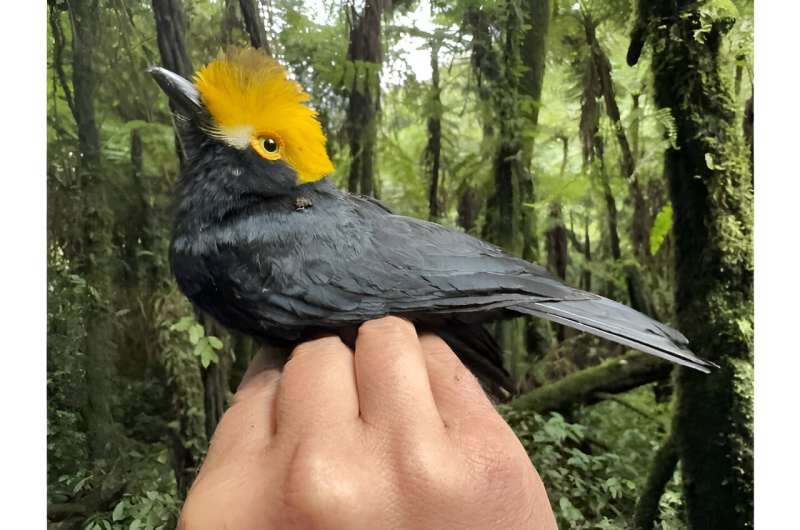This article has been reviewed according to Science X's editorial process and policies. Editors have highlighted the following attributes while ensuring the content's credibility:
fact-checked
trusted source
proofread
First known photos of 'lost bird' captured by scientists

For the first time, scientists have captured photos of a bird long thought lost. Known as the Yellow-crested Helmetshrike, or Prionops alberti, the species is listed as a 'lost bird' by the American Bird Conservancy because it had not seen in nearly two decades.
University of Texas at El Paso scientists made the discovery during a six-week expedition to the Itombwe Massif, a mountain range in the eastern Democratic Republic of the Congo. The photos of the helmetshrikes have been reviewed and confirmed by Cameron Rutt, Ph.D., who leads the Lost Birds project at the American Bird Conservancy.
"It was a mind-blowing experience to come across these birds. We knew they might be possible here, but I was not prepared for how spectacular and unique they would appear in life," said Michael Harvey, Ph.D., an ornithologist and UTEP assistant professor in the Department of Biological Sciences.
Harvey co-led the expedition with UTEP Professor of Biological Sciences Eli Greenbaum, Ph.D. They were joined by ornithologist Matt Brady, as well as a group of Congolese researchers from the Centre de Recherche en Sciences Naturelles, including Chifundera Kusamba, Ph.D., Robert Kizungu Byamana, Chance Bahati Muhigirwa, Mwenebatu M. Aristote, and Wandege M. Muninga.
The team trekked by foot for over 75 miles through the depths of the Itombwe Massif, studying birds, amphibians, and reptiles along the way.
While exploring the cloud forests on the slopes of a mountain, Harvey and Brady stumbled upon the helmetshrike—a striking black bird with a bright yellow "helmet." The team said they appeared as rather "noisy and active groups in the midstory of the forest."
The bird is endemic to the western slopes of the Albertine Rift of Central Africa, according to Harvey, a region that has been largely inaccessible due to war and security issues but that has recently become safer to visit.
In total, about 18 birds were found at three sites during the expedition.
"This inspires hope that perhaps the species still has a reasonably healthy population in the remote forests of the region," Harvey said. "But mining and logging, as well as the clearing of forests for agriculture, are making inroads deep into the forests of the Itombwe range. We are in discussions with other researchers and conservation organizations to further efforts to protect the region's forests and the helmetshrike."
Harvey added, "Right now is a golden opportunity to protect these tropical forests so that we don't lose species like the helmetshrike before they are known and studied."
The expedition, which ran from December 2023 to January 2024, yielded other important discoveries. The herpetology team rediscovered the Red-bellied Squeaker Frog, or Arthroleptis hematogaster, which had not been seen since the 1950s. The frog rediscovery has been confirmed by David Blackburn, Ph.D., professor at the University of Florida's Museum of Natural History.
"UTEP's global impact is showcased through not just the accomplishments of its graduates but also through groundbreaking and captivating discoveries, exemplified here by the contributions of Drs. Greenbaum and Harvey," said UTEP College of Science Dean Robert Kirken, Ph.D. "I hope this discovery illuminates and inspires students and scientists worldwide."
Provided by University of Texas at El Paso




















